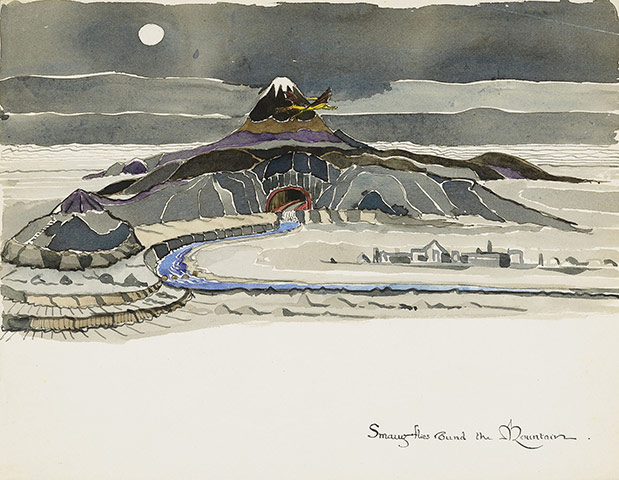Rhiannon
Well-Known Member
The city of Dale is the setting for a lot of this season's frame story, as it is the site of the Seven-Year Commemoration of the Battle of Five Armies. Since the frame is set seven years after the events of The Hobbit, a lot of the men from Lake-town have moved back there and begun to rebuild; however, not everything is completed.
The people of Dale are interested in restoring their city to its glory of old, so any descriptions of pre-Smaug Dale likely apply to it now. It should be set in "the valley overshadowed by the Mountain," near the river. It should have plenty of golden bells, and, of course, "towers and houses frail" (although probably less frail than they were).
Here are some illustrations of Dale by Tolkien and his illustration of Lake-town, which would likely have similar architecture to Dale.





There are a couple of places in Dale invented in the scripts:
The people of Dale are interested in restoring their city to its glory of old, so any descriptions of pre-Smaug Dale likely apply to it now. It should be set in "the valley overshadowed by the Mountain," near the river. It should have plenty of golden bells, and, of course, "towers and houses frail" (although probably less frail than they were).
Here are some illustrations of Dale by Tolkien and his illustration of Lake-town, which would likely have similar architecture to Dale.





There are a couple of places in Dale invented in the scripts:
- The Gatehouse Market: Because of Bard's high taxes, many human and Dwarven merchants have had to set up outside the walls of Dale.
- "An indoor market is set up in a large building outside the walls of Dale. Stalls manned by Human and Dwarven MERCHANTS line the road to the gate, and several alleys branch off from it, leading to more stalls. The market is full of CUSTOMERS, haggling with the Merchants."
- The Main Square: There is a small stage set up here for Bard's wife, Ragna, to perform on. This is also the site of the memorial for Smaug's attack on Esgaroth.
- "They come to an immense relief carving, which the camera pans over. Dale of old. Dale burning. A line of carven people from moving Dale to Esgaroth. Barrels floating in the lake. Esgaroth aflame. A carving of Bard with his bow drawn and the thrush by his ear. The camera suddenly flicks along the path the arrow would take to a carving of the Dragon in the sky."
- The Hall of Girion: This is the main hall in Dale, basically Bard's Heorot.
- "It is rustic but impressive. The walls are made of freshly-cut wood laid on scorched and blackened stone – the foundations of the old hall. Tall pillars, also of fresh wood, support the high roof. The pillars are painted with scenes of the lake and the natural world surrounding Dale, as well as Men of Dale hunting, fishing, trading, and doing other activities. While the paintings are nice, they seem unfinished. Many figures are mere outlines, as if the artist sketched them out in order to make sure the pillars were completely covered with art before the Seven-Year Commemoration and may return later to fill them in. Long tables line the hall, and a few chairs sit near the blazing fireplace at one end. Bard’s throne sits at the head of the main table. It is made of wood and carved with many animals. Notably, there is a bear on one side and a life-size thrush where the chair rises above his shoulder. His wife’s throne is beside his. It is less ornate but still finely carved."
- Observatory Tower: This is where Gandalf and Bilbo go to look at the Moon-letters on Durin's Day.
- "BILBO and GANDALF are at the top of one of the newly built towers that has many windows. They can clearly see the moon and the sun in the sky at the same time."
- The Red Dragon Inn: This is where Bilbo reveals to Balin the message on the instructions for Dragon-proof doors.
- "The first shot shows a sign with a red Dragon (one of Tolkien’s drawings of Smaug) painted on it: The Red Dragon Inn. The inn is newly built and looks warm and cozy. Inside, BILBO and BALIN are drinking and conversing together."

